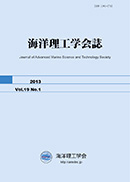24 巻, 2 号
選択された号の論文の5件中1~5を表示しています
- |<
- <
- 1
- >
- >|
原著
-
2018 年 24 巻 2 号 p. 1-8
発行日: 2018年
公開日: 2018/12/28
PDF形式でダウンロード (18874K) -
2018 年 24 巻 2 号 p. 9-18
発行日: 2018年
公開日: 2018/12/28
PDF形式でダウンロード (3473K) -
2018 年 24 巻 2 号 p. 19-30
発行日: 2018年
公開日: 2018/12/28
PDF形式でダウンロード (1585K) -
2018 年 24 巻 2 号 p. 31-37
発行日: 2018年
公開日: 2018/12/28
PDF形式でダウンロード (1035K)
寄稿
-
2018 年 24 巻 2 号 p. 39-44
発行日: 2018年
公開日: 2018/12/28
PDF形式でダウンロード (10993K)
- |<
- <
- 1
- >
- >|
